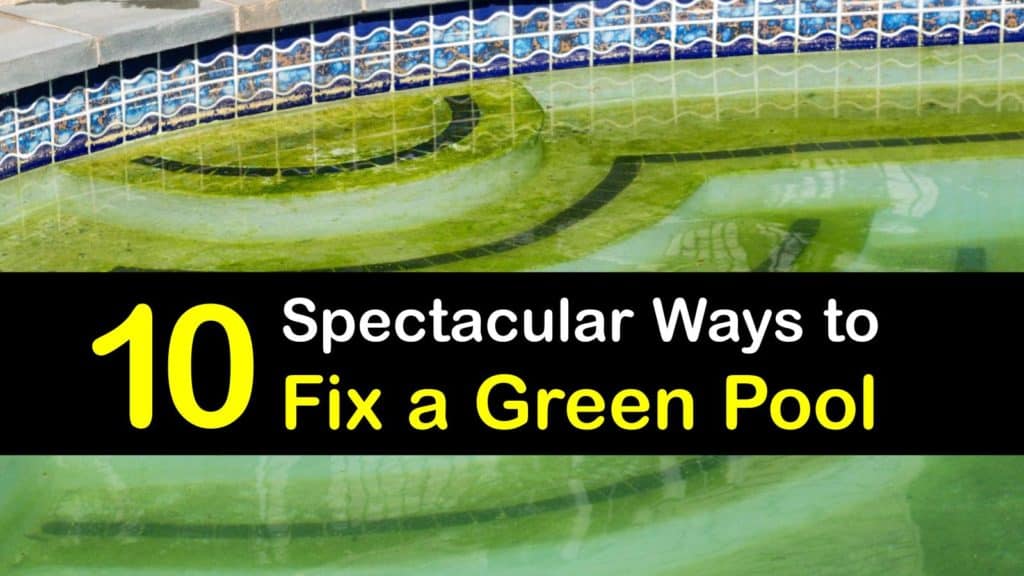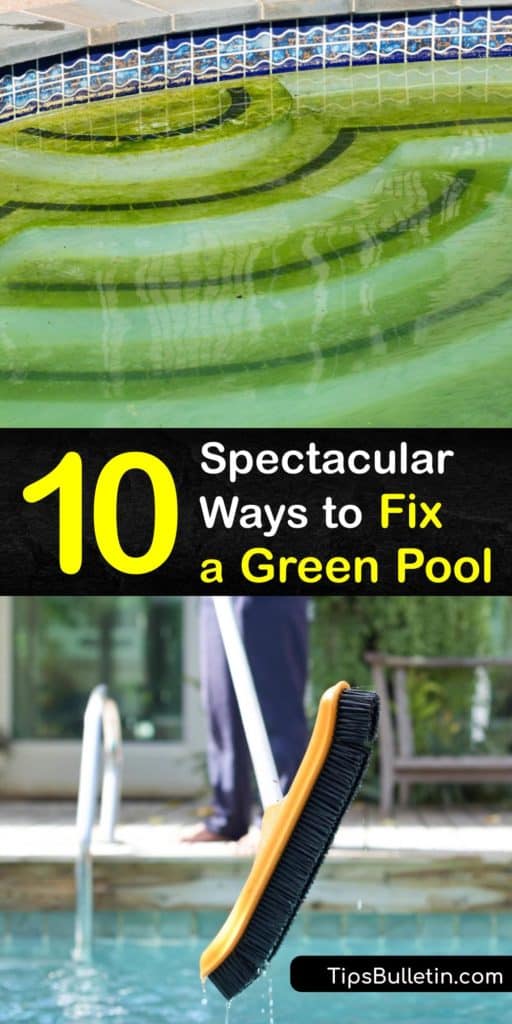As the summer heat takes over, we often find ourselves dying for something to cool us off and save us from the scorching sun. Those who are lucky enough to have a pool soon realize how big a chore it is to take care of it. You can’t prevent algae from growing in your pool, and that’s why learning how to clean a green pool makes it so you can enjoy the fresh water while soaking up vitamin D from the sun throughout the entire summer.
Trying to fix a green pool can be one of the most frustrating tasks for homeowners. If you have a chemical imbalance or your alkalinity levels are off, then it means that algae are growing fast, and soon, your entire pool turns into a murky mess.
Follow these steps on how to clean a green pool with bleach and other chemicals so that you and your family get to enjoy all the benefits of the refreshing water without spending hours cleaning it every week.

- Why Does Algae Grow?
- How to Clean a Green Pool
Why Does Algae Grow?
Whether you are cleaning above ground pools or an in-ground system, cleaning a green pool fast is something that every pool owner wants to do in the late spring. The sooner you’re able to clear a cloudy pool, the less you have to worry about the upkeep.
We can’t learn how to clean a green pool without understanding water chemistry and what makes algae grow. How do you fix a green pool? A green swimming pool is a given after you remove the cover in late spring.
However, green algae in your pool doesn’t stay that way for long if you know how to take care of it properly. Algae grows depending on the temperature, amount of sunlight, and water circulation in that environment.
In general, it doesn’t need a lot to survive. As long as they have sunlight and food, algae thrive in nearly all bodies of water. Even though algae isn’t toxic to swimmers, it is not a good bacteria and can cause an assortment of problems.
One issue is that algae will clog your filter and render it almost useless. Algae is microscopic and hides in all crevices of pools, including behind pool ladders and under the liners.
You have to be hyper-vigilant about getting these nooks and crannies to save our future selves from unnecessary work.
How to Clean a Green Pool
Knowing how to get pool water clear is a crucial piece of knowledge for pool owners. Getting the chlorine levels and pH level under control is the most critical step of the entire cleaning process.
Once you clear the debris and utilize your filtration system, you’ll soon be swimming in perfectly clear pool water, and your whole family and friends will be begging to come over to take a dip.

Removing calcium from pool tiles and the bottom of the pool is also important. After getting rid of the algae, tackle calcium deposits with a brush.
The First Step to Fix a Green Pool
After you remove the cover and take in the visual shock of your green swimming pool, it’s time to get started removing the sediment and dead algae. The first step in learning how to clean a green pool is to remove all of the debris to clear up the green water.
If you cannot see six to eight inches below the surface, the pool must be drained and acid washed. Thankfully, this is a rare occurrence, and likely won’t be a step you have to take.
To start removing the debris from the pool, eliminate the algae’s food source and get the chlorine working for you. Grab your skimmer and lift out as many dead leaves and other gunk as possible.
Once you’ve skimmed the top surface of the water, switch the skimmer to a pool net and scoop out all of the big debris from the bottom of the pool.
Testing the Pool Chemicals
When you have removed a majority of the sediment with your skimmer and pool net, it’s time to test the water’s chemical levels. Purchasing a water test kit at your local pool store helps make the maintenance a lot easier.
These tests come in kits that measure the alkalinity, liquid chlorine, cyanuric acid, and bromine levels of your water.
While performing your pool tests, validate that each is at the correct level or use chemicals to adjust them to where they are supposed to be.
Your pool’s pH level should remain between 7.4 and 7.6 on the pH scale. Healthy alkalinity levels range from 100 parts per million (ppm) to 150 ppm.
If the cyanuric acid is below 30 ppm, the sun breaks down the free chlorine levels that keep the algae at bay. If it’s too high, then you’ll have to remove some of the pool water and replace it with fresh water.
How to Clean a Green Pool with Bleach
Testing the levels of your green swimming pool helps you determine what steps you need to take next. Once you get your pH level adjusted, it’s time to shock the pool. This step gets completed with either granular chlorine, bleach, or calcium hypochlorite.
Always read the package directions and use the appropriate amount for the size of your pool. After you determine how much chlorine your pool requires, follow the directions and add the specified amount to the water.
Do a free chlorine test again after an hour to determine that it is at or above the appropriate shock level.
Use a testing kit to check the cyanuric acid levels of your pool. If the levels are below 20 ppm, then it is safe to add bleach to your pool.
To mildly shock a 30,000 gallon pool, dilute one gallon of bleach with some water in a large bucket and pour it directly into the pool water. For a more concentrated shock, use two and a half gallons of bleach. Keep the filter running until the water starts to clear.
Running Your Pool Filter
It doesn’t matter if you have an inground or above ground pool; every single one has a pool filter. The most common two filters are a cartridge filter and a sand filter.
Cartridge filters must be cleaned manually with a hose to remove all of the grime from the cartridge spaces. Sand filters have a backwashing system that allows you to clean the filter with a switch.
There are also diatomaceous earth filters called a DE filter. Diatomaceous earth is a sedimentary rock used to clean the water, but they are far less common than cartridge and sand filters.
Clean your pool’s cartridge filter or backwash your sand filter before rerunning it. Make sure your filter is running while you have the shock in the pool to help it circulate throughout the water.
Vacuuming Your Pool
A lot of work gets done while your pool pump is running. One of the most important things to do to help clear up the cloudy water is to run a vacuum. Sometimes you can hook up a pool vacuum to the pool’s skimmer to work automatically, or you may do it by hand.
Before you start vacuuming to get algae off bottom of pool, use a brush and scrub down all the sides of your pool to prepare to kill brown algae on pool walls or the liner.
You may have to backwash or spray down your filter more often during this process because so much dead algae get picked up and run through your pump.
After 24 hours of vacuuming and adding chlorine, you’ll notice a drastic difference, and the water won’t be nearly as green as it was before.
Testing Pool Levels Again
When you let your pool sit overnight, huge changes are happening. Your water is turning clearer because you’ve thoroughly brushed it, vacuumed it, and performed tests on it. Even though you added chemicals the day before, you might have to add some again.
Sun and algae deplete your chlorine levels, so it’s essential to perform another free chlorine test after the sun has gone down and you wake up the following morning.
If you complete a test and have a loss in chlorine, there are still algae in the pool. When this happens, then it’s time to shock the pool again until those levels remain consistent.
The Magic of Algaecide
Getting your water’s chemical levels under control is one of the most complex parts of pool maintenance. Once maintained, incorporate other things that will help keep your pool clear.
The easiest way to fix a green pool is to add algaecide, a chemical that comes in either liquid or powder form. Algaecide prevents growth and maintains the crystal-clear waters in your pool.
As always, read the instructions posted on the label to ensure you’re putting the right amount into your pool and performing the process correctly.
Keeping Chlorine Levels Up
As summer goes on and the heat levels continue to rise, keeping chlorine in your pool is a tough challenge. Liquid chlorine and chlorine tablets are some of the most accessible products that ensure that your chlorine levels stay where they’re supposed to be.
If you use chlorine tablets, place a few of them in your pool hopper, so it flows back into the water without requiring you to do any more work. Liquid chlorine is another option and is added directly to the water.
Keep Your Filter Running
You’d be surprised how much work your pool filter does throughout the day. If you really want to learn how to clean a green pool with bleach, then one of your safest actions to take is to keep the filter running.
Pool filters keep water and chlorine circulating and constantly filter out bacteria and other harmful things that get into the water.
On top of that, make sure that you clean your pool filters regularly. Clean or backwash your filters several times per week for ideal performance.
Practice Regular Pool Maintenance All Summer
The only way to guarantee that your pool water stays clear all summer long is to keep up with regular maintenance. Pools are not something that you can sit back and forget.
If you wait too long to check on the pool chemicals, then the pool is going to turn green before you know it, and you’ll be back where you started at the beginning of the season.
Test your pool water regularly, preferably once per day. If that’s too much for you, then testing it once per week is also acceptable. Make sure to stock up on pool chemicals at the beginning of the season so that you can make all necessary adjustments.
It also helps to brush and vacuum your pool at least once per week, but more than that is preferred. This also applies to cleaning your pool filter regularly and doing any upgrades when necessary.
We all love swimming in a cool pool when the sun is blistering hot. As much as we love them, pools are a lot of work and take up a lot of our free time. The more you stay on top of the upkeep, the easier it is to maintain.

If learning how to clean a green pool has helped you splash around all summer long, share these steps to remove algae from your pool on Facebook and Pinterest.